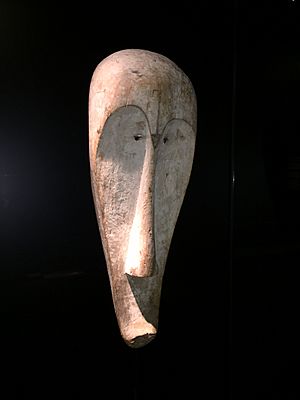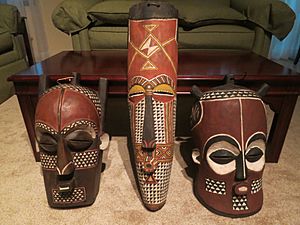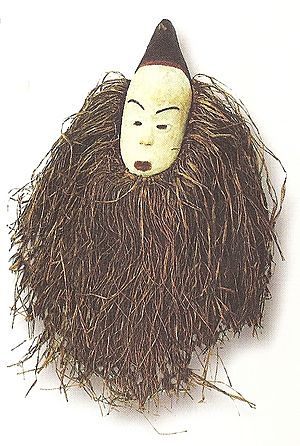Traditional African masks facts for kids
Traditional African masks are a very important part of African culture and art. These masks have even inspired artists in Europe and the Western world, especially in the 1900s. Art styles like cubism and expressionism got ideas from the many different African masks. You can also see their influence in masked parades like Carnival in South America and Central America.
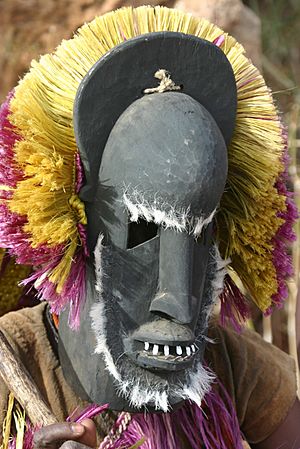
Masks are a key part of traditional life for people in Sub-Saharan Africa, from the Sahara Desert down to the Kalahari Desert. Even though what the masks mean can be different in each culture, some things are the same. For example, masks usually have a spiritual or religious meaning. They are used in special dances and events. The artists who make the masks and the people who wear them are highly respected. Often, the skill of making masks and the knowledge of their meanings are passed down from fathers to sons. African masks come in many bright colors, like red, black, orange, and brown.
In many traditional African cultures, when someone puts on a mask, they are believed to stop being just a person. They become the spirit that the mask represents. This change often happens with special music, dances, or costumes. These things help the person wearing the mask feel like they are no longer themselves. The mask wearer then acts as a go-between for the community and the spirits. These spirits are often ancestors or spirits connected to nature. Masked dances are part of many important African ceremonies. These include weddings, funerals, and coming-of-age rituals. Some cultures, like the Yoruba and Edo in Nigeria, have very complex mask rituals. These rituals are sometimes like a type of theatre.
Each mask has its own special spiritual meaning. Because of this, most traditions have many different types of masks. For example, the Dogon people of Mali have three main spiritual groups. Each group has its own spirits, and there are 78 different types of masks in total! Often, how artistic and detailed a mask is shows how important the spirit it represents is. For instance, simpler masks like the kple kple from the Baoulé people of Côte d'Ivoire are for less important spirits. They are usually just a circle with simple eyes, a mouth, and horns.
Contents
What African Masks Look Like
African masks usually look like a human face or an animal's snout. But they are often made in a very abstract way, not exactly like real life. This is because many African cultures believe that the true meaning of something is more important than how it looks. So, artists focus on showing the "essence" or spirit of what they are making. For example, the nwantantay masks of the Bwa people in Burkina Faso represent invisible forest spirits. Because these spirits can't be seen, the masks are made of abstract, geometric shapes.
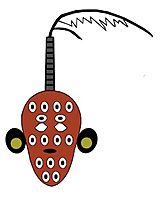
The style and features of a mask often follow old traditions. These styles can show which community made the mask or what special meanings it has. For example, both the Bwa and Buna people in Burkina Faso have hawk masks. But the shape of the hawk's beak tells you if it's a Bwa or Buna mask. The hawk's wings often have geometric patterns that teach moral lessons. Saw-shaped lines might show the difficult path ancestors took. Checkered patterns can represent how opposites, like male and female or night and day, work together.
Many cultures use mask features to show moral values. Masks from the Senufo people of Ivory Coast, for instance, have half-closed eyes. This symbolizes being peaceful, having self-control, and being patient. In Sierra Leone, small eyes and mouths often mean humility. A wide, sticking-out forehead can mean wisdom. In Gabon, large chins and mouths show authority and strength. The Grebo people of the Ivory Coast carve masks with round eyes to show alertness and anger. A straight nose on their masks means they are unwilling to give up.
Animal Masks
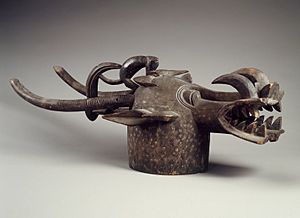
Animals are very common subjects for African masks. Animal masks might represent the spirit of an animal. This way, the person wearing the mask can speak to the animals themselves. For example, they might ask wild animals to stay away from the village. But often, an animal also stands for certain good qualities. Common animals seen on masks include the buffalo (which often means strength), crocodile, hawk, hyena, warthog, and antelope. Antelopes are very important in many cultures in Mali, like the Dogon and Bambara. They represent agriculture and farming.
Dogon antelope masks are very abstract. They are usually rectangular with many horns, which represent a good harvest. Bambara antelope masks, called chiwara, have long horns that show how well millet grows. Their legs represent roots, and long ears represent the songs women sing while working during harvest. A saw-shaped line on the mask shows the path the Sun takes between the solstices. An old painting from the 12th or 13th century in Old Dongola shows dancing masks. These masks are decorated with cowrie shells and look like animals with long snouts and big ears.
Sometimes, masks combine features from several different animals, and even human traits. Mixing animal features can show unusual strength or high status. For example, the Poro secret groups of the Senufo people in the Ivory Coast have masks that combine three "danger" symbols: antelope horns, crocodile teeth, and warthog fangs. This shows the society's great power. Another example is the kifwebe masks of the Songye people in the Congo basin. These masks mix the stripes of a zebra or okapi, the teeth of a crocodile, the eyes of a chameleon, the mouth of an aardvark, the crest of a rooster, and the feathers of an owl.
Feminine Beauty in Masks
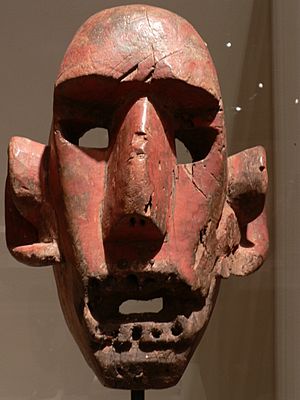
Another common subject for African masks is a woman's face. These masks usually show what a specific culture thinks is the ideal of feminine beauty. For instance, female masks of the Punu people of Gabon have long curved eyelashes, almond-shaped eyes, a thin chin, and traditional decorations on their cheeks. All these are seen as beautiful features. Feminine masks of the Baga people have decorative scars and breasts. In many cases, only men are allowed to wear masks that represent female beauty.
One famous mask showing female beauty is the Idia mask from Benin. It is believed that King Esigie of Benin ordered this mask to honor his mother. The king wore the mask on his hip during special ceremonies to remember her.
Ancestor Masks
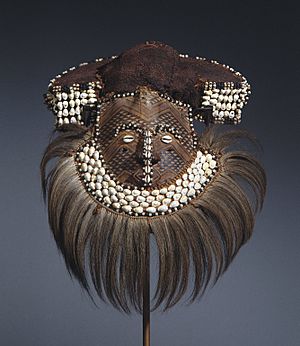
Honoring dead ancestors is a very important part of most traditional African cultures. So, it's not surprising that masks often represent ancestors. Masks that refer to dead ancestors are usually shaped like a human skull. A well-known example is the mwana pwo mask from the Chokwe people of Angola. Its name means "young woman." This mask combines features of feminine beauty, like a well-shaped oval face, small nose, and chin. But it also has features that suggest death, like sunken eye sockets, cracked skin, and tears. It represents a young female ancestor who died early. This mask is honored in rituals like circumcision rites and ceremonies that celebrate new life.
Some ancestor masks are made to honor famous people from history or legends. For example, the mwaash ambooy mask of the Kuba people in DR Congo represents Woot. Woot was the legendary founder of the Kuba Kingdom. The mgady amwaash mask represents his wife, Mweel.
Materials and How Masks Are Worn
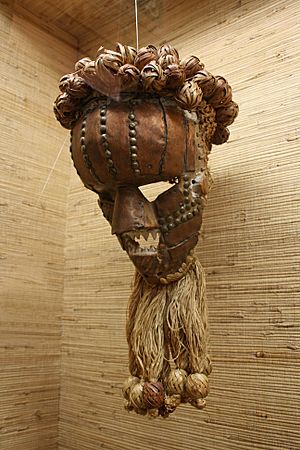
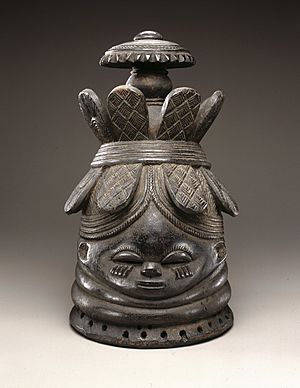
The most common material used for masks is wood. However, many other materials can be used. These include light stone like steatite, metals like copper or bronze, different types of fabric, and pottery. Some masks are painted using natural colors like ochre. Many decorative items can be added to the mask's surface. Examples include animal hair, horns, or teeth, sea shells, seeds, straw, egg shells, and feathers. Animal hair or straw are often used for the mask's hair or beard.
How a mask is made depends on how it will be worn. The most common type covers the wearer's face, like many masks you might see at a carnival. Other masks are worn like hats on top of the head. Examples include masks from the Ekhoi people of Nigeria and the Bwa people of Burkina Faso. The famous chiwara masks of the Bambara people are also worn this way. Some masks, like those from the Sande society of Liberia and the Mende people of Sierra Leone, are made from hollow tree stumps. These are worn like helmets, covering both the head and face. Some African cultures have mask-like decorations that are worn on the chest instead of the head or face. The Makonde people of East Africa use these in their ndimu ceremonies.
Masks for Sale Today
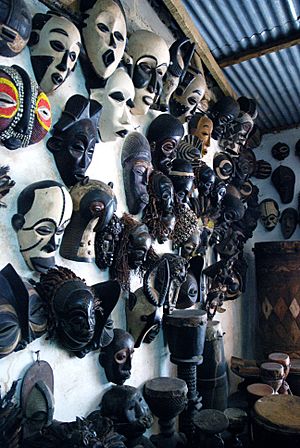
African masks are very popular with people from Europe and other parts of the world. Because of this, they are widely sold in markets and shops for tourists in Africa. You can also find them in "ethnic" shops in the Western World. This means that the traditional art of mask-making has changed. It used to be a special practice for certain people, but now many masks are made for mass production.
Most commercial masks are copies of traditional ones, but this connection is becoming weaker. Because so many masks are made quickly, it's harder to know where they originally came from. For example, the Okahandja market in Namibia mostly sells masks made in Zimbabwe. These are cheaper and easier to get than local masks. And in Zimbabwe, mask-makers often copy masks from all over Africa, not just their own local traditions.
See also
 In Spanish: Máscaras africanas para niños
In Spanish: Máscaras africanas para niños



